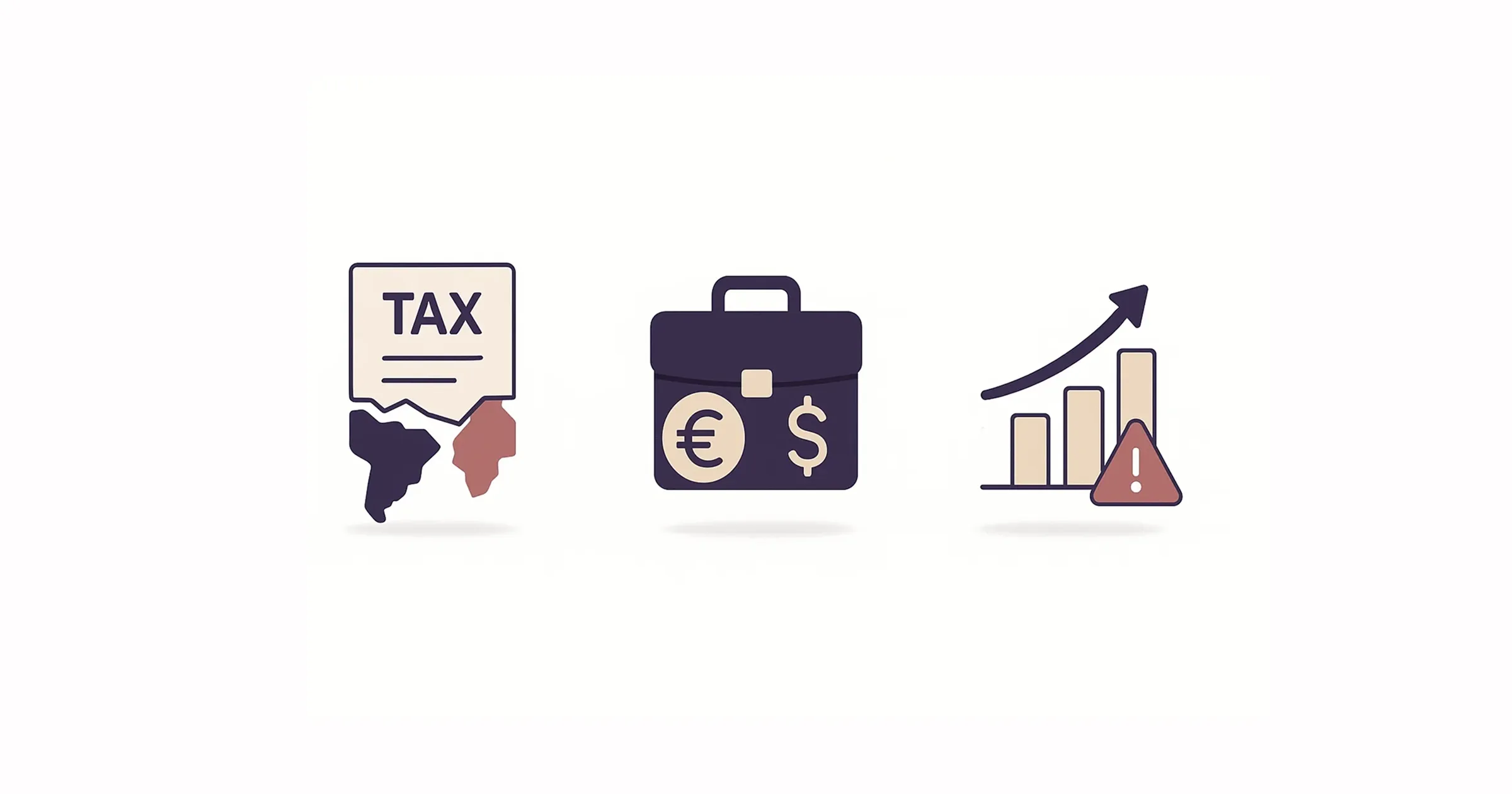Strategic Cross-Border VAT Planning for International Growth
Expanding your business internationally opens the door to new opportunities – but also to complex tax obligations that CFOs and Financial Directors must navigate carefully. From income tax and cross-border regulations to the complexities of international VAT, a well-structured approach is essential. In this cross-border tax planning guide, we’ll walk through the key steps, explore recent regulatory changes, highlight common pitfalls, and offer practical strategies to reduce risk and strengthen your global tax position – even in complex cases like inheritance or real estate.
Step 1: Understand the Fundamentals of Cross-Border Taxation
Before you implement any planning, it’s crucial to grasp the essential layers of cross-border taxation. Different jurisdictions apply different rates, filing deadlines, and regulations for both income tax and indirect taxes like VAT.
- Profit shifting causes $100–240 billion in corporate tax losses globally each year, according to the OECD.
- Multinational profit shifting costs EU countries around €36 billion annually, or 7.7% of their corporate tax revenue, according to the EU Tax Observatory.
Grasping Local vs. International Obligations
You must know how tax rules differ locally and internationally. For instance, some countries impose withholding taxes on cross-border transactions, while others offer tax credits or exemptions. Understanding this interplay is a core part of any effective tax planning guide – and it can help you avoid double taxation, reduce liabilities, and stay compliant across jurisdictions.
Step 2: Evaluate Key Regulatory Changes
As global tax rules become more complex, staying ahead of regulatory shifts is essential. New reporting obligations and global standards are changing how multinational businesses manage compliance, structure transactions, and calculate liabilities. Two of the most impactful developments come from the European Union and the OECD.
- EU DAC6 Reporting Rules: The EU’s DAC6 directive requires companies and intermediaries to disclose certain cross-border tax arrangements that could be used for aggressive tax planning. This has increased transparency across EU jurisdictions.
- OECD Global Minimum Tax (Pillar Two): The OECD’s Pillar Two framework introduces a 15% global minimum tax for large multinational enterprises. It's projected to raise up to $220 billion annually in additional corporate tax revenues.
- Global Adoption: Over 140 jurisdictions have joined the OECD/G20 Inclusive Framework and committed to implementing these minimum tax rules as part of the BEPS action plan.
These policy shifts signal a more coordinated global approach to tax enforcement. For CFOs and tax leaders, evaluating these rules early helps prevent compliance failures and align internal structures with international expectations.
What This Means for CFOs
Keeping up with evolving legislation is crucial. Missed disclosures and late filings can lead to penalties, which can easily outweigh any tax advantage you hoped to gain. Monitor developments in your key business regions to ensure you’re always prepared.
Step 3: Identify Potential Pitfalls

Global expansion involves a web of regulatory bumps:
- Double Taxation Disputes: A 2023 European Commission staff working document indicates that 94% of EU corporate taxpayers have faced double taxation conflicts at least once. Leading tax experts note that mismatches in tax residency definitions and intangible asset valuations often trigger these disputes.
- Hidden Offshore Wealth: The IMF estimates that hidden offshore assets result in around $150 billion/year in unpaid global income taxes.
- Soaring Compliance Costs: European Commission data shows that EU businesses spend about €204 billion/year on tax compliance - around 1.9% of their turnover. Between 2014 and 2019, these costs increased by 114%.
When these pitfalls converge - for instance, if you’re audited for suspected income shifting while also grappling with new VAT rules - the result can be overwhelming. A clear, structured plan helps eliminate guesswork. For practical compliance steps and a global checklist, visit the Global Sales Tax Solutions & VAT Compliance Guide.
Step 4: Map Out a Comprehensive Income Tax and Cross Border Tax Guide
The next step is to create a structured roadmap to plan cross-border taxes. This roadmap can help you minimize overlapping obligations and manage potential audits:
- Organize Country-Specific Rules: Keep an internal database of tax rates, filing deadlines, and current legal changes for each region.
- Assess Transfer Pricing Requirements: Make sure you document intercompany transactions thoroughly, anticipating any local country benchmarks or disclosures.
- Check for Tax Treaties: Many bilateral agreements provide reduced withholding taxes or tax credits for cross-border operations.
Coordinating Income Tax and Cross Border Tax Implications
Even though our focal point is often VAT in the global arena, do not ignore direct taxation. GDPR, Pillar Two, and local rules can intensify your compliance responsibilities.
-
Confirm if your company structure is recognized consistently across all jurisdictions.
-
Evaluate whether any local special tax incentives (e.g., patent boxes or R&D credits) apply to your operations.
-
For help with documentation and tailored advisory, consider VAT Consulting for International Businesses.
Step 5: Manage VAT Strategies
Strategic VAT management forms a cornerstone of income tax and cross border tax. Especially across the EU, VAT can be a bigger concern than corporation tax, given monthly or quarterly filing cycles and considerable penalty structures.
- Digital Services & E-Commerce: If you’re selling to consumers in many EU countries, you might need to register in each country where you exceed the sales threshold.
- Export & Import VAT: Clarify who is responsible for VAT at each stage in your supply chain. The wrong decision about the “Incoterms” or contract details can lead to unexpected VAT bills.
Businesses should also review VAT Compliance: How EU Businesses Lost €159M in Penalties for cautionary tales and best practices.
Dealing with “Digital Nomad” Programs
Since 2020, the number of countries offering new tax visas for remote work has grown, appealing to employees seeking personal tax advantages. However, before making any relocations, be sure to confirm how these visas affect your organization’s VAT obligations and permanent establishment status. Incorporating remote work scenarios into how you plan cross-border taxes is essential to avoid unexpected liabilities.
Step 6: Align Transfer Pricing Approaches
Transfer pricing plays a key role in cross-border tax compliance. If not handled properly, it can trigger audits and significant penalties.
Profit shifting impact:
- According to the OECD, multinational profit shifting causes $100–240 billion in lost corporate tax revenue globally each year, roughly 4–10% of total corporate income tax collected.
Why it matters:
- To avoid being flagged for aggressive tax planning, companies need clear and consistent transfer pricing strategies. This means properly documenting how prices are set for transactions between related entities - especially when intangible assets or specialized services are involved.
What to do:
- Follow the OECD Transfer Pricing Guidelines, including Master File, Local File, and Country-by-Country Reporting requirements.
- Review and update your transfer pricing documentation regularly - especially after business model changes or expansion into new markets.
Building a strong, defensible approach to transfer pricing helps reduce risk and shows tax authorities that your company operates transparently across borders.
Step 7: Continuously Monitor and Adjust
Managing cross-border taxation isn’t a one-time exercise – it’s an ongoing process. Tax laws evolve, enforcement tightens, and what worked last year may not hold up today.
To stay compliant and optimize your global tax position:
- Conduct regular audits: Review your international tax setup quarterly or annually to ensure alignment with current laws and filing obligations.
- Gather local insights: Collect feedback from regional finance teams to identify operational or regulatory risks early.
- Adjust to new rules: Update your strategy when major changes occur, such as the 15% global minimum tax under OECD Pillar Two.
A strong cross-border tax plan must adapt continuously - especially when managing both income tax and indirect tax risks across jurisdictions. Regular monitoring helps you stay ahead of compliance issues and uncover potential savings.
A Quick Definition of Income Tax and Cross Border Tax
Income tax and cross border tax involves organizing business activities and finances across more than one country to reduce overlapping tax liabilities, manage compliance, and ensure that legal requirements are met in each jurisdiction. This planning typically covers both direct (income) and indirect (VAT) taxes, leveraging treaties and consistent documentation to minimize risks. A well-structured income tax and cross border tax guide helps businesses navigate these complexities with clarity and confidence.
Conclusion
Strategic cross-border tax management goes beyond paperwork – it's about creating a clear strategy that covers both direct and indirect taxes. A well-structured cross-border tax planning guide helps businesses reduce costs, avoid double taxation, and stay compliant. By monitoring rules, managing VAT, and reviewing transfer pricing regularly, CFOs can protect their companies and focus on international growth.


